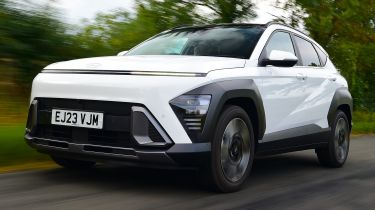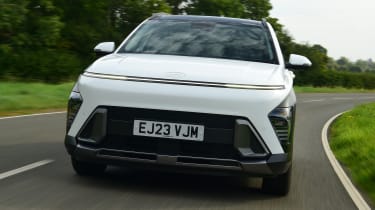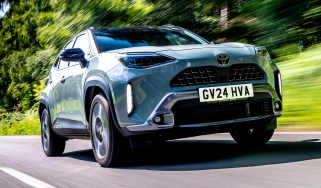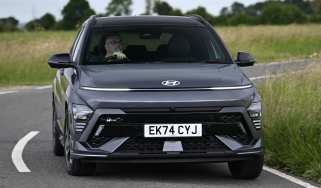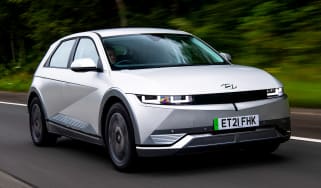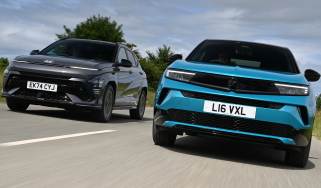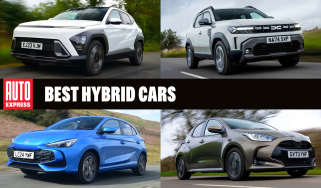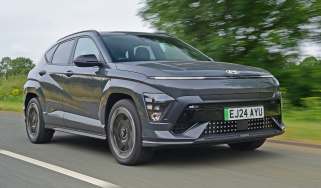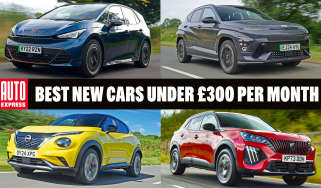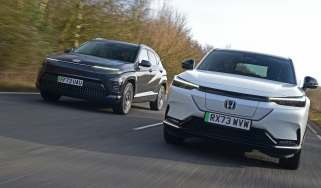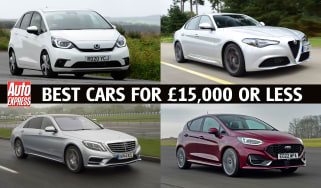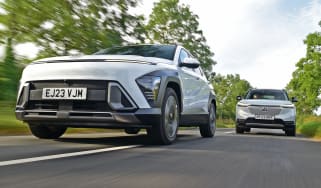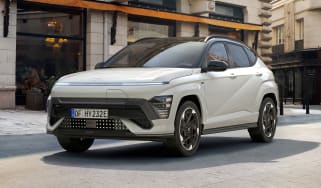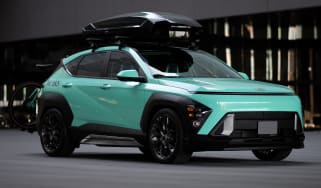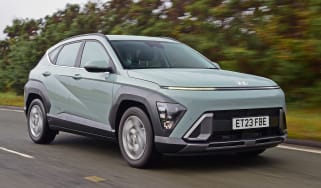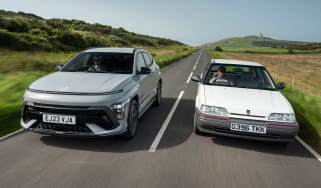Hyundai Kona review
The Hyundai Kona is comfortable, refined, spacious and overflowing with technology

Our opinion on the Hyundai Kona
The Hyundai Kona is a fantastic example of how a brand can listen to feedback and act upon it. Hyundai has grown its small SUV sensibly in order to deliver enough practicality to satisfy those looking for their next family car. Its interior has been improved, too, with a smart look, logical layout, and an intuitive infotainment system.
Admittedly, the daring, sci-fi-inspired styling might not be for everyone, and there are cheaper compact SUVs out there, but the Kona – and the Kona Electric in particular – looks extremely good value for such a mature, well equipped and well-rounded car.
About the Hyundai Kona
The latest Hyundai Kona may have grown in size compared with its predecessor, but its key rivals remain the cream of the crop in the small SUV and crossover segment. Among them are the Ford Puma, Renault Captur, and Skoda Kamiq, plus the Kona’s Niro sister car. A few of these are also offered with a choice of combustion and electric power, in the case of the Niro, Avenger, and 2008.
The Kona has stuck with the same choice of petrol, hybrid, and electric powertrains as its predecessor. The entry-level petrol only comes with a six-speed manual gearbox, while the more powerful 1.6 petrol is available in manual or seven-speed dual-clutch automatic forms. The hybrid comes with its own six-speed dual-clutch automatic. All versions of Kona are front-wheel drive.
Hyundai Kona prices and latest deals
How much does the Hyundai Kona cost? Well, official ‘on the road’ prices range from £26,465 to £39,390 but you can currently save an average of £3,612 through the Auto Express Find A Car service, where prices start at £23,685. You can lease a Hyundai Kona from £305 per month or buy a used model at prices starting from £17,000.
Check out our latest new car deals, leasing deals and used car deals for the top offers available now on Auto Express. And don't forget we can help you sell your car, too.
Engines, performance and drive
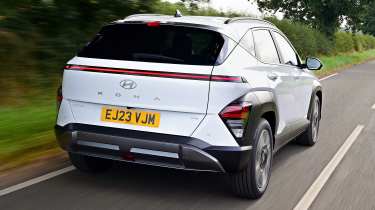
Pros |
|
Cons |
|
The Hyundai Kona is a car that encourages you to take it easy when behind the wheel, and has been set up to be a comfortable family car rather than one that’ll set your trousers on fire. It’s happiest around town, where you can drive the Kona Hybrid and Kona Electric with just the accelerator thanks to one-pedal driving modes, recuperating energy and boosting the car’s efficiency.
Performance, 0-60mph acceleration and top speed
The 1.0-litre petrol Kona produces just 99bhp and 172Nm of torque, and is the slowest model in the range: it’ll ‘sprint’ from 0-62mph in 13.3 seconds, and go onto a top speed of 105mph. It’s sufficient for keeping up with traffic in town, and you can keep the engine on the boil using the pleasingly accurate and relatively short throw of its standard six-speed manual gearbox, which we found to be much more satisfying to use than the manual in the Nissan Juke.
Used - available now
The 1.6-litre petrol models produce a healthier 136bhp and 250Nm of torque – enough for 0-62mph in 10.2 seconds and a top speed of 121mph. But while the 1.6-litre motor packs decent punch, we found progress can be spoiled by the jerky dual-clutch automatic transmission, which never felt properly in tune with the engine. Stick with the manual.
The Kona Hybrid pairs a 1.6-litre petrol engine with a single electric motor to drive the front wheels. Combined, the set-up produces 127bhp and 265Nm of torque, which is good for 0-62mph in 12.0 seconds. However, we found that after the initial pep of the electric motor, the petrol engine provides more noise than it does propulsion, and the acceleration tails off significantly once you go past 50mph. Once you’re at motorway speeds, though, there’s still enough oomph available for overtaking.
The Kona Electric use a single 215bhp electric motor driving the front wheels. It's 255Nm has no trouble overcoming the extra weight of its heavier battery pack, giving it a 0-62mph dash of just 7.8 seconds. If you’d like to know more, we have a dedicated review of the Hyundai Kona Electric via the link provided.
| Model | Power | 0-62mph | Top speed |
| Kona 1.0T manual | 99bhp | 13.3 seconds | 105 mph |
| Kona 1.6T manual | 136bhp | 10.2 seconds | 121mph |
| Kona 1.6 hybrid | 127bhp | 12.0 seconds | 93 mph (Eco mode), 103 mph (Sport mode) |
| Kona Electric | 215bhp | 7.8 seconds | 107 mph |
Town driving, visibility and parking
Despite the Kona being bigger in every physical dimension, it remains just as manoeuvrable as its predecessor, with a tight 10.6-metre turning circle helping to deliver decent manoeuvrability around town. The steering is so light that you can turn the wheel with one finger, which is a real boon when parking. The trade-off is virtually no feedback, though.
All editions come with front and rear parking sensors plus a reversing camera as standard. A 360-degree camera system is fitted to high-end N-Line S and Ultimate trims, along with a blind spot camera feed of what’s alongside you, which is shown in the instrument cluster when you use the indicators.
Overall, the Kona is comfortable, with nothing that will upset occupants too severely, and bumps are soaked up easily by the suspension.
Country road driving and handling
The chassis of the Kona offers safe and predictable handling. It isn’t particularly thrilling, and the steering remains light and devoid of feedback at higher speeds. It’s certainly no Ford Puma when it comes to driving satisfaction.
The sportier N Line model doesn’t receive any stiffer suspension settings, which is probably a good thing because the standard set-up delivers a good balance between tidy handling and a comfortable ride.
Motorway driving and long-distance comfort
At higher speeds, the petrol engine in the hybrid version does a lot more work than the electric motor, which is likely to have an impact on fuel efficiency, while wind noise when cruising at the national limit harms refinement a little. The ride in N-Line models becomes more unsettled at speed, too, although some rivals, such as the Vauxhall Mokka, are even more unruly.
If you value comfort over looks on a long trip, the 17-inch rims that feature on entry-level Advance-spec models (and are an option on Ultimate trim Kona Electric models to lessen rolling resistance and improve electric range) contribute to a more settled ride quality. We think the lower trim petrol offers more compliance than the higher-end editions and the electric version. The latter helped, no doubt, by the fact that it weighs a few hundred kilos less than those carrying hefty EV batteries.
Activate the adaptive cruise control with steering assist, and the system responds to other traffic well, while smoothly following the curve of the lane you’re in.
“Different drive modes are designed to boost performance or efficiency, but I find that for most of the time, the standard setting is perfectly acceptable.” – Dean Gibson, senior road test editor
MPG, CO2 and running costs
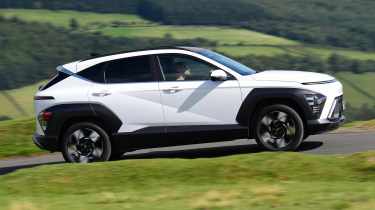
Pros |
|
Cons |
|
Like the original, the Mk2 Hyundai Kona is available with a choice of pure-petrol, full-hybrid or all-electric power. The 1.0-litre petrol Kona will return up to 47.9mpg and 135g/km on average. Meanwhile, 1.6-litre petrol Konas can average up to 45.6mpg and 141g/km.
The Kona Hybrid pairs a 1.6-litre four-cylinder petrol engine and six-speed automatic transmission with an electric motor and a tiny 1.32kWh battery. Because this is a full-hybrid, not a plug-in hybrid (PHEV), you don’t charge the Kona Hybrid yourself; instead, the car recuperates energy when you slow down and helps the Hyundai’s petrol-electric powertrain to deliver decent real-world fuel efficiency
During our time with the Hybrid, we saw a return of 53.7mpg while driving on a mix of roads. This included a number of motorway miles, where the petrol engine does more work than the electric part of the drivetrain – if you’re able to avoid high-speed runs, we see no reason why the Kona’s claimed fuel economy of 60.1mpg couldn’t be within reach.
One minor gripe we have is the Kona Hybrid’s comparatively small fuel tank. At 38 litres, it’s smaller than the 47-litre tank in the petrol Kona, and is even beaten by the more compact Vauxhall Mokka, which has a 42-litre tank. However, the theory goes that electric running will compensate for the capacity drop, so you shouldn’t have to stop any more frequently in the Hybrid than in its rivals.
| Model | MPG | CO2 | Insurance group |
| Kona 1.0T manual | 48.7mpg | 131g/km | 14E |
| Kona 1.6T manual | 45.5mpg | 141g/km | 21A |
| Kona 1.6 hybrid | 60.1mpg | 106g/km | 16E |
Electric range, battery life and charge time
All versions of the Kona Electric come with the same battery capacity of 65.4kWh. The best version for electric driving range is the entry-level Advance model with smaller 17-inch wheels, offering 319 miles of range. The bigger wheels of N-Line, N-Line S and Ultimate cut the range to 289 miles, although you can opt for smaller wheels on the Ultimate trim to increase your range. Read more about the Hyundai Kona Electric in our dedicated review.
Insurance groups
Your powertrain choice has the biggest impact on the car’s group rating, with the least powerful petrol models falling into group 14, the Hybrid starts in group 16, the more powerful petrols in group 21 and the all-electric variants as high as group 31.
If you need a small SUV with lower insurance costs, consider either the SEAT Arona, which in entry-level 1.0 TSI SE form is in group nine, or if you’re after a hybrid, the Toyota Yaris Cross in 1.5 Icon trim is in group 11.
Tax
There’s a 27 per cent Benefit-in-Kind (BiK) band rate for the Kona Hybrid, so while it offers savings over petrol models, it’s the super-low rates of the all-electric version that are going to be more attractive to business users.
Road tax is competitive across the Kona line-up, although the highest-spec N Line S and Ultimate versions of the Kona electric only just come in below the £40,000 luxury car threshold, so even adding metallic paint will see these break that barrier and face a far bigger road-tax bill for years two to six.
Depreciation
Electric models tend to take a hit when it comes to used values, and that’s evident in the Kona’s residuals. According to figures sourced from CDL Vehicle Information Services, the standard petrol models retain around 49-54 per cent of their value after three years and 36,000 miles, while the all-electric versions retain around 45 per cent.
In comparison, the Renault Captur maintains between 52 and 55 per cent of its value, while the Alfa Romeo Junior Elettrica will be worth 50 to 52 per cent of its original value over the same period.
To get an accurate valuation on a specific model check out our free car valuation tool...
Interior, design and technology
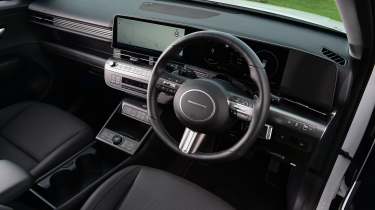
Pros |
|
Cons |
|
Its space-age exterior design owes a lot to Hyundai’s futuristic Ioniq EVs, although the Kona still manages to have a look all of its own. It combines this with plenty of practical touches and logically laid-out tech.
Entry-level Advance trim gets 17-inch alloy wheels (18-inch on hybrids), dual-zone climate control, a 12.3-inch central touchscreen with sat-nav and Apple CarPlay and Android Auto smartphone connectivity, front and rear parking sensors, plus a reversing camera.
Our preferred N Line trim has a sporty look, but also includes other useful features such as:
- Heated front seats
- Heated steering wheel
- Wireless smartphone charging
- Powered tailgate
Next up is N Line S trim, adding Alacantara and leather upholstered seats (heated and ventilated) with electric adjustment, three-zone air conditioning and a Bose sound system. N Line and N Line S models are also available with a two-tone roof.
Finally, sitting at the top of the Kona line-up is the Ultimate trim. Range-topping models get a full-width daytime running light at the front, LED headlights, black leather seats, a sunroof and the Bose stereo.
A few optional extras are available, with the particular highlights being the Comfort pack on entry-level Advance Kona Electric models that adds heated seats all around, a heated steering wheel and wireless phone charging, or the Lux pack available on N Line S or Ultimate trims, which includes memory settings for the driver’s seat, and Hyundai’s ‘Premium Relaxation’ front seats that recline – a somewhat useful feature in the electric version that allows you to rest more comfortably while waiting for your car to charge when taking a long trip.
Interior and dashboard design
While the Kona’s exterior features plenty of flamboyant touches, the cabin is a more straightforward affair. The colours and materials vary according to trim level, with the sportier N Line versions featuring a darker overall theme with plenty of red detailing throughout and some suede-effect upholstery on N-Line S trim.
The Kona’s twin-screen layout features a pair of 12.3-inch displays set side-by-side, but the rest of the buttons are a little spread out around the cabin – there are buttons immediately below the main screen, but then there are more further back surrounding the infrequently used drive-mode selector, which seems like it’s been added as an afterthought.
Materials and build quality
The feel of the materials inside is good, although the plastic trim used for the button panels on the centre console is a little on the hard side. The controls themselves work without an issue, though, with a positive action for the buttons and rotary controls, while the overall fit and finish is good. It’s not quite as plush as a premium model, but occupants shouldn’t have any complaints.
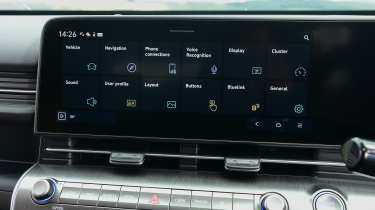
Infotainment, sat-nav and stereo
Every Kona features a 12.3-inch display behind the steering wheel paired with another 12.3-inch central touchscreen. The displays all look great and are fairly responsive, too.
The home page is made up of large blocks, so finding the right menu is relatively straightforward, but you can always use the physical shortcut buttons below the screen if you want. Alternatively, you can also use your favourite music and navigation apps via Apple CarPlay or Android Auto, which are standard-fit but not wireless.
A DAB radio and Bluetooth are standard, while N-Line S and Ultimate trims get an uprated BOSE sound system.
“N-Line S and Ultimate trim models feature a blind-spot camera system that’s common across other high-end Hyundai models, and is activated when you use the indicators. This provides a feed from a wing mirror-mounted camera that shows the side of the car towards the rear. It’s a clever idea, but in practice the images are sent to the driver’s display where they’re rather out of sight if you’re looking at your surroundings.” - Dean Gibson, senior road test editor
Practicality, comfort and boot space
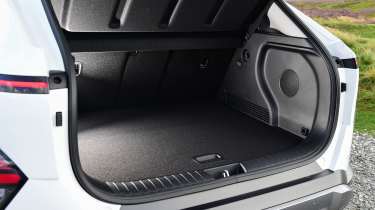
Pros |
|
Cons |
|
Larger exterior dimensions than its predecessor mean that the second-generation Kona has more usable space than before, making it a viable option for families.
Dimensions and size
The Kona has grown in size for its second generation. The original Kona measured 4,205mm long, 1,800mm wide (2,070mm including door mirrors) and up to 1,568mm tall, while the Mk2 Kona is 4,350mm long, 1,825mm wide (2,100mm including door mirrors) and 1,585mm tall. The Kona’s wheelbase has also been stretched from 2,600mm to 2,660mm on the new model.
| Dimensions comparison | |||
| Model | Hyundai Kona | Skoda Kamiq | Renault Captur |
| Length | 4,350mm (4,385mm N-Line & N-Line S) | 4,241mm | 4,239mm |
| Width | 1,825mm (2,100mm inc mirrors) | 1,793mm (1,986mm inc mirrors) | 1,797mm (2,004mm) |
| Height | 1,585mm | 1,531mm | 1,575mm |
| Wheelbase | 2,660mm | 2,651mm | 2,639mm |
| Boot space | 466-1,300 litres | 400-1,395 litres | 422-1,363 litres |
Seats & passenger space
There’s plenty of room in the front of the Kona, while the steering wheel and seat have a wide range of adjustment for most body types to get comfortable.
Storage is generous, with the wide centre console being a particular highlight. The cup-holders feature spring-loaded sides that can be moved out of the way to make space for larger items, and there are trays ahead of and behind this section, too. One gripe we have is that there isn’t a hidden storage compartment under the central armrest, but otherwise, there’s plenty of space for odds and ends.
Leg and headroom in the back of the Kona is much improved over the previous generation, so much so that it’s one of the best small SUVs around – it offers nearly as much space as the larger Tucson.
It’s not quite as wide, though, so shoulder space is tighter, but still good for the class. There’s a centre armrest (a feature not offered in smaller rivals such as the Vauxhall Mokka), while rear passengers also benefit from seatback nets, twin air vents and a pair of USB-C sockets to match the two up front. One minus point is the door bins, which are only big enough for a drinks bottle.
Two Isofix child seat mounting points are provided on the outer positions of the 2nd row seats.
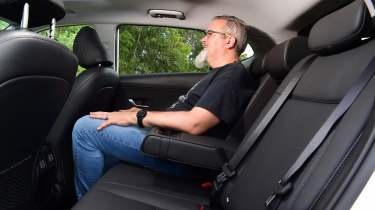
Boot space
Choose a Kona in N Line spec or above, and it will have a height-adjustable powered tailgate. This opens to reveal a low loading lip and a generous 466 litres of space, which is more than the 400 litres provided in the Skoda Kamiq and the 422 litres of space found in a Renault Captur.
There aren’t many novel features offered in the Kona Hybrid, such as under-floor storage or a sliding rear bench like you get in a Renault Captur, nor the nifty underfloor storage box in the Ford Puma that can be easily washed out if you happen to put muddy hiking boots in it. You do get a 40:20:40 split rear seat, adding some additional flexibility when dropping the rear seats, and revealing up to 1,300 litres of space. That’s a respectable amount for a small SUV, but it is around 100 litres shy of the Kamiq.
Towing
The entry-level 99bhp petrol Kona has a maximum towing capacity of 1,210kg, but the 136bhp petrol can haul up to 1,310kg. The 1.6 Hybrid drops down to 1,010kg.
The Kona Electric is even less capable, with only 750kg towing capacity. That’s a little disappointing when the extended range versions of the Volvo EX30 can handle up to 1,600kg.
"Charging everyone’s devices should be a doddle, because there are two USB-C ports in the rear, another two up front along with a 12V socket, with some models also featuring a wireless charging pad. I also like that there’s plenty of storage spaces dotted around the cabin, although I wish a couple more were covered in some way to help keep valuables out of sight." – Ellis Hyde, news reporter
Reliability and safety
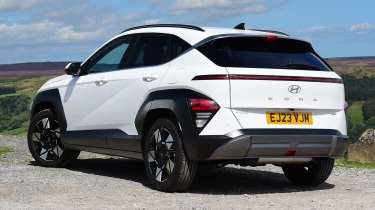
Pros |
|
Cons |
|
Hyundai finished 20th out of 31 brands in our best car manufacturer rankings (based on Driver Power survey results). The South Korean carmaker placed ahead of Volkswagen (27th), but behind the likes of Kia (18th), Volvo (13th), Skoda (12th), and Honda (10th).
The Mk2 Kona received a disappointing four-star out of five rating from safety experts Euro NCAP when it was tested in 2023. The safety experts criticised structures behind the dashboard posing an injury risk, and that the driver slipped under the seatbelt in the frontal collision test (a scenario known as submarining), potentially causing damage to the knees and femur. However, it wasn’t the only SUV to fall foul of the tougher test, because the Honda ZR-V also got four stars out of five, although the Honda did perform better than the Hyundai in child occupant and vulnerable road user protection, along with a superior safety assistance score.
Every Kona is equipped with multiple airbags, driver attention warning, forward collision avoidance assist, lane keep and lane follow assist, tyre pressure monitoring, front and rear parking sensors, and a reversing camera. Any automatic petrol, hybrid, or electric Kona also gets adaptive cruise control with stop-and-go functionality, whereas all manuals come with regular cruise control.
N Line S and Ultimate spec also feature a rear cross traffic collision avoidance system to warn you of vehicles crossing your path – useful if you have to reverse onto a main road, blind spot monitoring to let you know of any vehicles alongside you on the motorway if you wish to change lanes, and a 360-degree camera system, among other kit.
During our group test of the Kona against a Vauxhall Mokka, we found that the Kona has a distracted driver sensor that’s a bit too keen to beep if you take your eyes off the road. You can program a shortcut to the star button on the steering wheel to turn off the speed limit warning.
| Euro NCAP safety ratings | |
| Euro NCAP safety rating | Four-stars (2023) |
| Adult occupant protection | 80% |
| Child occupant protection | 83% |
| Vulnerable road user protection | 64% |
| Safety assist | 60% |
Buying and owning
Best buy: Hyundai Kona Electric Advance Comfort Pack
Out of the petrol, hybrid and electric ‘engines’ available in the Kona, it’s the electric version that gets our recommendation because it offers the sort of pulling power you need with a car full of people, plus it has refinement benefits over the petrol and hybrid models.
Entry-level Advance comes with plenty of equipment for the money, but we’d recommend spending an extra £600 for the comfort pack, which includes heated front and rear seats, a heated steering wheel, wireless smartphone charging and rear privacy glass.
Hyundai’s five-year, unlimited-mileage warranty is still one of the strongest on the market. Some rivals can match it, though, while sister firm Kia still edges ahead with its seven-year/100,000-mile warranty cover. Electric versions of the Kona also come with a separate eight-year/100,000-mile guarantee for the battery pack.
Hyundai Kona alternatives
The Kona remains one of our preferred small SUV choices, but if you're looking for practicality on a budget, the excellent Dacia Duster offers the former in spades while maintaining a sensible list price.
Keen drivers will be best served by the Ford Puma. It remains unmatched despite being around for a while, and its zippy 1.0-litre Ecoboost engines feature mild-hybrid technology to boost fuel economy. We also highly rate its innovative MegaBox storage solution, which allows taller items to be stored in the boot without having to fold the seats down.
The Renault Captur has a party trick of its own: the back seats slide to offer more rear leg room or a bigger boot, depending on your needs at the time. We also highly rate its Google-based infotainment system as being one of the quickest and easiest to use.
Deals on the Hyundai Kona and alternatives
Hyundai Kona Electric Ultimate long-term test
Our art director, Darren Wilson, ran a Hyundai Kona Electric for six months and from day one he was constantly reminded why this small SUV was our 2023 Car of the Year. The Kona’s easy-to-use technology, generous helping of safety equipment and practical layout all made a very positive and lasting impression.
Darren also loved the way the Kona looks, which was no doubt helped by the fact the car was designed and engineered as an EV before anything else. A downside? Colder temperatures resulted in a range drop from over 300 miles to around 240 miles. You can read the full long-term test here…
Hyundai Kona pictures
Frequently Asked Questions
We recommend going for the all electric version in bigger 64kWh form because it has the best electric range and fastest charging speed. We’d suggest you stick with the entry-level Advance trim, but add the reasonably priced Comfort pack with heated seats all around for those cold winter mornings.
